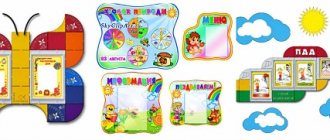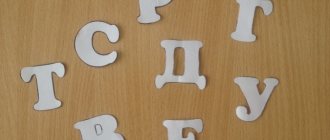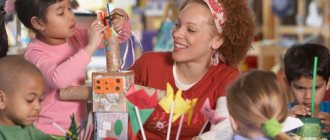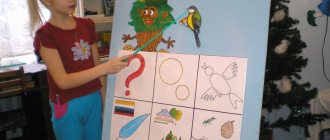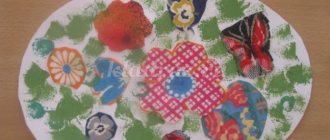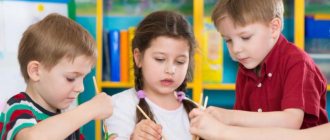Subject-developmental environment in the middle group of kindergarten within the framework of the Federal State Educational Standard
Slide 1 Subject-based developmental environment in the middle group of a kindergarten within the framework of the Federal State Educational Standard. Completed by: Levshakova O.V, teacher of MBDOU “Kindergarten No. 18” “Crane” Specialist of the 1st qualification category
Slide 2 Subject development environment in preschool educational institutions. Particularly relevant today is the issue of organizing the subject-development environment of preschool educational institutions. This is due to the introduction of the Federal State Educational Standard (FSES) to the structure of the basic general education program of preschool education. In accordance with the Federal State Educational Standard, the program should be built taking into account the principle of integration of educational areas and in accordance with the age capabilities and characteristics of students. The solution of program educational tasks is provided not only in the joint activities of adults and children, but also in the independent activities of children, as well as during routine moments. Everyone knows that the main form of work with preschoolers and the leading activity of children is play. That is why we educators are experiencing an increased interest in updating the subject-development environment of preschool educational institutions.
Slide 3 What is a subject-specific developmental environment? (Terminology) The child’s development environment in the structure of the Federal State Educational Standard is a complex of material and technical, sanitary and hygienic, social, social, social, ergonomic, aesthetic, psychological, pedagogical, and spiritual conditions that ensure the organization of the lives of children and adults in preschool educational institutions.
Slide 4 Federal State Educational Standard requirements for a subject-development environment: 1. Accessibility for students of all premises of the organization where the educational process is carried out. 2. Free access for pupils to games, toys, materials, and aids that provide all basic activities.
Slide 5 Factors that should be taken into account when organizing PRS. Children should be protected in every possible way from the negative influence of toys that: provoke the child to aggressive actions and cause cruelty, provoke game plots associated with immorality and violence that are beyond the competence of childhood. Anthropometric factors ensuring compliance of height and age characteristics with the parameters of the subject development environment. Furniture must be in accordance with the requirements of SANPiN and Federal State Standards
Slide 6 The subject development environment should facilitate the implementation of educational areas in the educational process, including: 1) joint partnership activities of adults and children; 2) free independent activity of the children themselves in the conditions of a subject-based developmental educational environment created by teachers, which ensures that each child chooses activities according to his interests and allows him to interact with peers or act individually.
Slide 7 The subject-spatial development environment should be organized taking into account the requirements of the Federal State Educational Standard, where all five educational areas are clearly visible: 1) socio-communicative,
2) educational,
3) speech,
4) artistic and aesthetic,
5) physical.
Slide 8 Approximate centers for educational areas in light of the requirements of the Federal State Educational Standard Social and communicative development: Cognitive development: Speech development Artistic and aesthetic development Physical development: Traffic Safety Center
Fire Safety Center
Labor Center, Duty Corner
Game activity center (center for role-playing games)
Sensory Development Center
Center for Constructive Activity
Center for Mathematical Development
Experimentation Center Speech Development Center or Speech and Literacy Corner
Speech therapy corner Fine Arts Center or creativity corner
Center for Musical and Theatrical Activities Center for Physical Development - Sports Corner “Be Healthy!”
Slide 9 When creating a subject-development environment in our group, we set ourselves the goal of doing this with minimal economic costs, since we cannot count on serious material investments in equipping the subject environment. We tried to make the subject-development environment diverse, bright, and rich in information, in order to maximally speed up and facilitate the adaptation period of children in kindergarten, create an emotionally positive atmosphere in the group, and ensure the individual harmonious development of the child. We followed the zoning principle. Thanks to the organization of various play areas and corners using open shelving that does not clutter the room. The group has created conditions for different types of children's activities (play, productive and cognitive-research). In order for each child to be able to find something to do and do something they like and feel comfortable, centers for a specific type of activity are allocated in the group.
Slide 10 Direction: Artistic and aesthetic development. There is material and equipment for artistic and creative activities: drawing, modeling and appliqué. If desired, the child can find and use what is necessary to realize his creative ideas, plans, and fantasies. This center has free access.
Slide 11 Direction: Speech development plays a significant role in developing children’s interest and love for fiction. In this corner, the child has the opportunity to independently choose a book according to his taste and calmly examine it with bright illustrations.
Slide 12 Direction: Cognitive development. Center for Experimental Activities. It contains material for carrying out experimental activities: magnifying glasses, flasks, measuring cups, funnels, hourglasses, soil, stones, seeds, cereals, etc. Our little “whys” conduct simple experiments and determine the properties of various natural materials.
Slide 13, 14 includes environmental activities. This corner contains various types of indoor plants, which are convenient for demonstrating modifications of parts of the plant, tools for caring for these plants: sticks for loosening, a spray bottle, watering cans, etc. In addition to indoor plants, this center contains models (desert, animal world, aquarium , birdhouse, beehive, birdcage, etc.).
Slide 15 It’s winter outside, but in the group on the windowsill it’s spring. During the cold season, my children and I create a mini-vegetable garden on the windowsill. This is an opportunity for children to have live communication with plants. Anyone who starts such a vegetable garden will certainly become interested in experimentation and eco-design. I arranged the winter garden with great imagination: I designed it in the form of a village yard, decorated it with suitable buildings and decorative accessories.
Slide 16 The “construction” (constructive) center, although concentrated in one place and takes up little space, is quite mobile. Its practicality lies in the fact that with the contents of the construction corner (various types of construction sets, large and small construction sets), you can move to any place in the group and organize this activity.
Slide 17 (toy library) The center solves the following tasks: purposefully developing children’s interest in elementary mathematical activities, instilling in children the need to occupy their free time with not only interesting, but also games that require mental stress and intellectual effort.
Slide 18 Direction: Social and personal development. Play is the main activity of our children. A bright, rich play center creates conditions for children’s creative activity, develops imagination, develops gaming skills and abilities, and fosters friendly relationships between children. Attributes for role-playing games emerging at this age are freely available to children: “Family” “Hospital”
Slide 19 “Barbershop”
"Theater"
Slide 20 “Shop” “Garage”
Slide 21 «
Subject-developmental environment of the middle group section
Author:
Arapova Natalya Olegovna,
teacher
MADOU d/s No. 176 of the city of Tyumen
Children are taught every minute, and with the arrival of summer, educational activities are transferred to the site. Our site has all the necessary conditions to ensure different areas of children’s development: play, motor, intellectual, independent activity.
The subject-developmental environment of the site that we have created allows us to ensure maximum psychological comfort for each child, to create opportunities for the exercise of his right to freely choose the type of activity, the degree of participation in it, the ways of its implementation and interaction with others.
At the same time, such a subject environment makes it possible to solve specific educational problems, involving children in the process of cognition and assimilation of skills and abilities, developing their curiosity, creativity, and communication abilities.
The design of the kindergarten site gives our students the opportunity to observe, explore, conduct experiments, work, and then reflect their impressions of interaction in theatrical, musical visual activities.
When entering our site, you find yourself in the atmosphere of an underwater kingdom; our veranda is a multifunctional structure, first of all, it is a shady space, which is necessary on hot summer days, as well as shelter from the rain. The underwater world helps to consolidate children's knowledge of colors and the development of imagination.
The veranda is equipped with boards for drawing with chalk, which contributes to the development of artistic and aesthetic perception.
And for drawing with pencils and wax crayons, there is a comfortable table with benches on the site.
Also, numbers and balls are depicted on the walls of the veranda, which helps to consolidate mathematical counting and identify the number of objects with a numerical image.
With the help of rings attached to the wall, as well as external material, children develop their physical skills. For cognitive development, there is an experimentation table on the site, made by the parents of the group, which opens up a variety of opportunities for children.
There is also a large sandbox with wet sand for playing with sand. Additionally, there is an inflatable pool on site for playing with water.
After “landing” we find ourselves in a completely different world, it is replete with bright colors and populated by fairy-tale characters who contribute to the social and communicative development of children.
To develop labor activity, there are a vegetable garden and flower beds on the site, which also contribute to the development of cognitive interest, environmental knowledge, observations and inferences of children.
To ensure hygiene, there is a washbasin in the area, which allows children to wash their hands or wash themselves at any time necessary.
When creating a subject-development environment in our area, I was guided by the following principles:
1. The principle of hygiene and protection of life and health (strength of buildings, flexibility of materials, the ability to process them, absence of piercing, cutting elements, etc.);
2. The principle of accessibility, i.e. objects of the developmental environment should be available to children for active use;
3. Principles of comprehensive development, i.e. the environment should harmonize the child’s personality, contribute to his aesthetic, physical, labor, moral, mental, environmental education and development;
4. The principle of consistency, i.e. the developing environment should contribute to the formation of systematic ideas about the objective, natural, and social world;
5. The principle of taking into account the individual and age-related characteristics of the child’s development;
6. The principle of variability (multifunctionality), which consists in a variety of options for using objects in the developmental environment of areas, playgrounds, corners and the entire territory of the kindergarten.
We invite teachers of preschool education in the Tyumen region, Yamal-Nenets Autonomous Okrug and Khanty-Mansi Autonomous Okrug-Yugra to publish their teaching materials: - Pedagogical experience, original programs, teaching aids, presentations for classes, electronic games; — Personally developed notes and scenarios of educational activities, projects, master classes (including videos), forms of work with families and teachers.
Why is it profitable to publish with us?
1. “Kindergartens of the Tyumen Region” is an officially registered specialized media outlet at the federal level. 2. The activities of the editorial office are supported by the Department of Education and Science of the Tyumen Region 3. We issue a “Certificate of Publication” in the media. 4. The document has a unique number, is entered in the register, has the original seal of the editorial office of the online publication and signature. 5. “Certificate of publication” in the media is sent to the author in both paper and electronic versions.
Details >>>
Sample “Certificate of publication of author’s methodological material in the media.”pdf
Share


